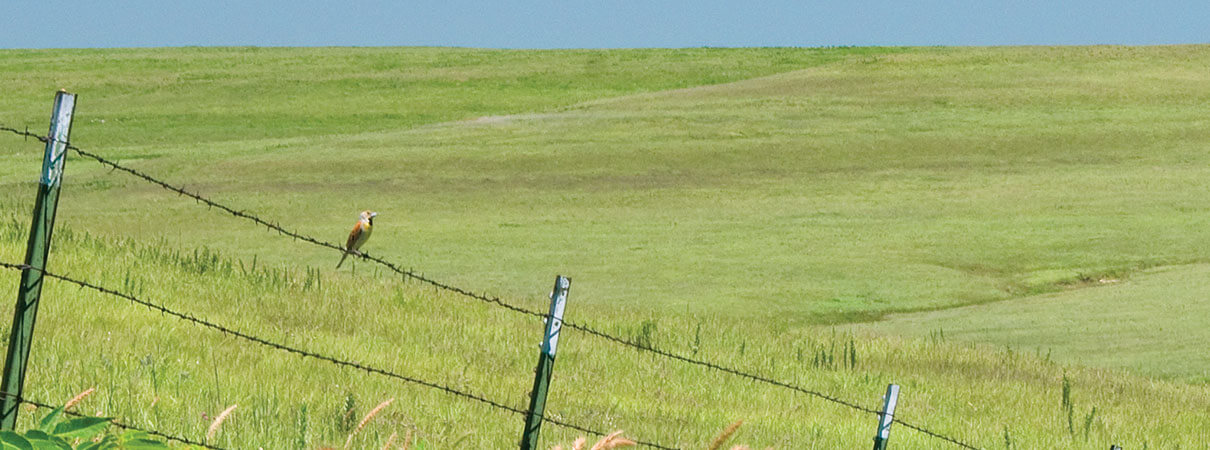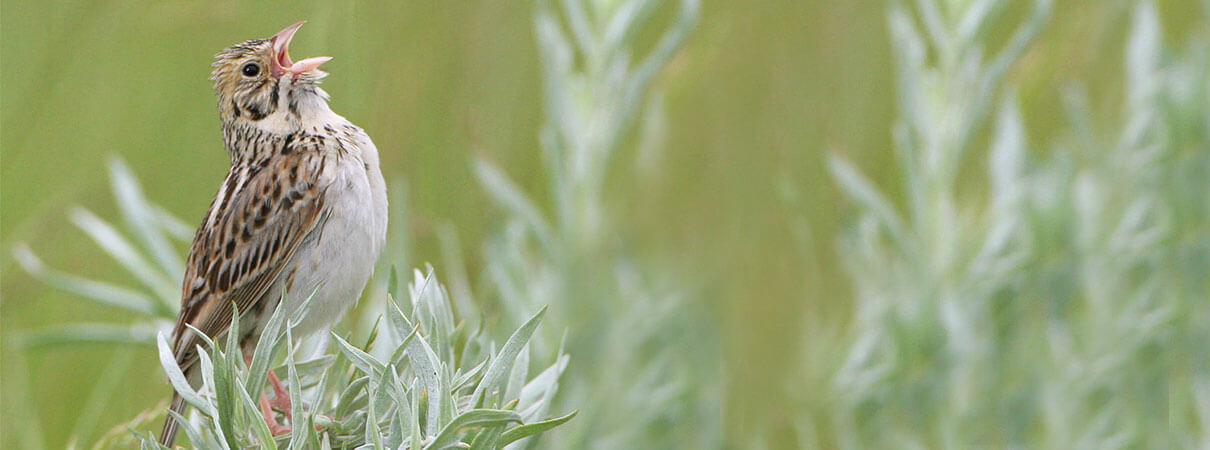A Banquet for Birds: Conservationists Boost Prairie Birds' Invertebrate Intake
Birds, like all animals, depend on a healthy environment to provide food sources. But as humans alter the natural landscape, traditional food and feeding dynamics have changed, creating new challenges for vulnerable bird populations. To help these birds, ABC partners with government agencies, other conservation groups, private landowners, and industry representatives to ensure carefully managed habitats — and thus healthy food supplies — are available.
In this, the second of our three-part series on efforts to increase natural food sources for birds, we look at how conservationists on the Great Plains are working with landowners to restore habitat and improve feeding opportunities for prairie birds.
Declining Grasslands, Vanishing Birds
Botanically diverse native grasslands, or prairies, once covered hundreds of millions of acres in America's heartland. This sea of grass and forbs directly and indirectly fed an abundance of wildlife. Enormous herds of American Bison and Pronghorn antelope flourished. So did millions of nesting birds, nourished by a bounty of seeds and a rich assortment of invertebrates, including grasshoppers, beetles, spiders, and ants. Once-common and now-declining bird species included Lark Buntings, Sprague's Pipits, Baird's Sparrows, and Chestnut-collared Longspurs. Invertebrates constitute a significant part of the diet for these birds, especially during the spring and summer breeding season.
But 97 percent of our tallgrass prairie and 47 percent of our Great Plains native grasslands have been lost in the past two centuries. As the prairie vanished, so did many native food sources, and many prairie bird populations. According to the North American Bird Conservation Initiative, six species of grassland-breeding birds, including the pipit, bunting, sparrow, and longspur, have declined between 68 and 91 percent.

Dickcissel. Photo by Cindy Tsutsumi
Responsible Ranching
Cheryl Mandich, ABC's Northern Plains Conservation Coordinator, is working with landowners to enhance habitat for grassland birds, efforts that help to optimize their food options. She works with landowners in the Dakotas, Montana, and Wyoming — the heart of prairie bird breeding territory.
Sometimes Mandich's work involves finding funding to plant native grasses and flowers on former cropland. Bringing back a mix of native plant species helps restore the birds' preferred breeding habitat and diet.
“But native plantings [on this scale] are very expensive and they take two or three years to establish,” says Mandich. “So ranchers lose those pastures for two or three years, and loss of grazing lands affects their livelihoods.”
So, more often, Mandich encourages ranchers to practice rotational grazing, moving cattle from one pasture to another at different seasons to create a patchwork of grass heights that promotes plant diversity, which in turn provides habitat for a multitude of insects. “Grasslands evolved with bison grazing,” she points out. “Bison go in and graze an area and then they move on, and they might not come back for a while. And that's how these prairie birds evolved.”

Chestnut-collared Longspur. Photo by Mike Parr
This patchwork approach boosts overall biodiversity. “What it does, especially for wildlife and grassland birds, is give you some pastures that are grazed a little heavier, some maybe not as much, and some that aren't touched,” she adds. “So you have that variety of plant structure.”
In addition to encouraging different plant heights, rotational grazing can positively affect the types of plants in a pasture. “If a pasture is grazed very heavily year after year, the cattle will go after their favorite species. So you're going to see a reduction in plant species, such as grasses and forbs. But if you start moving livestock around, those species will typically come back.”
Using Cattle to Control Weeds
Cattle can also be used to target some of the non-native plant species that crowd out native grasses and provide less value to birds and other wildlife. “I work with a landowner who's using cattle to control a noxious weed, Canada Thistle,” Mandich says. “He moves his livestock to pastures when Canada Thistle is pretty fresh, like in May, and the cattle will actually target it. It's high in protein.”
Mandich says that over the past four years, the rancher's new grazing practices, including targeting noxious weeds, have helped increase bird diversity on his land.
“We've seen some birds come in that I haven't seen there before, like Bobolink,” she says.

Baird's Sparrow. Photo by John Carlson
Keeping the Great Plains Green
Not only do sustainably managed grazing lands help ensure a better diet for prairie birds — they also provide better and more reliable forage for livestock. And what benefits livestock also benefits ranchers.
“We always have to keep in mind that this is their livelihood,” says Mandich, who grew up in a Michigan farming community. She and ABC see sustainable ranchers as important conservation partners in many open areas.
“If we lose the ranchers and they sell out, you run the risk of the ranch being bought and turned into something else,” says Mandich. “Keeping the ‘green side up' helps to ensure we have habitat for grassland birds, insects, and other wildlife species.”
Want to learn more about ABC's efforts to help nature feed birds? Check out Are Caterpillars Part Of The Cure For Ailing Cerulean Warblers? and Seafood For Seabirds: Puffins And Other Birds Depend On Human Restraint the first and third installments in our three-part series on boosting bird diets.
 | Mark Cheater is a writer, editor, and photographer who lives in Greenbelt, Maryland. |


















































